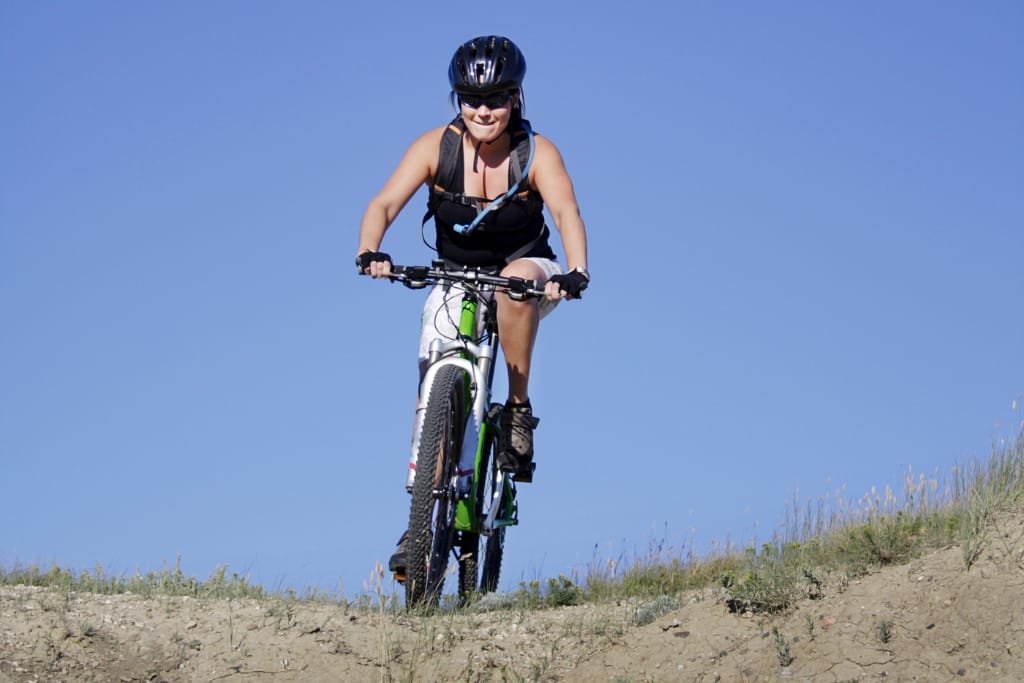Starting your mountain biking journey is an exciting opportunity to explore rugged trails, and breathtaking landscapes, and challenge your limits.
Whether you're looking to improve your skills, build confidence on technical routes, or simply enjoy the thrill of the ride, having the right guidance can make a huge difference.
These essential tips will set you up for success and ensure you're ready to tackle the trails with enthusiasm and ease—so let's gear up and get started!
1)) Choose The Right Bike
Choosing the right bike is one of the most important steps to kickstarting your mountain biking experience.
The key is to find a bike that matches your riding style, skill level, and the type of trails you plan to conquer.
From hardtails to full-suspension bikes, each model offers unique advantages designed for specific terrains and preferences.
Be sure to consider factors such as frame size, wheel size, suspension, and overall build quality, as these elements will directly impact your comfort and control on the trails.
Selecting a bike that feels natural and suits your needs will make every ride more enjoyable and help you thrive on your mountain biking adventures.
2)) Wear Proper Safety Gear
Wearing proper safety gear is essential to ensure a safe and enjoyable mountain biking experience.
A well-fitted helmet is non-negotiable, as it provides critical protection against head injuries.
Consider wearing gloves for better grip and hand protection, as well as knee and elbow pads to shield against scrapes and impacts during falls.
Proper footwear with sturdy soles will give you better control and stability on the pedals while moisture-wicking clothing keeps you comfortable throughout your ride.
Investing in high-quality safety gear not only boosts your confidence but also minimizes the risk of injury, allowing you to focus fully on the adventure ahead.
3)) Learn Bike Setup Basics
Learning the basics of bike setup is crucial for both performance and safety on the trails.
Start by adjusting your saddle height to ensure proper leg extension, which enhances pedaling efficiency and reduces the risk of strain.
Check your tire pressure as it directly affects traction and control on varying terrains—lower pressure provides better grip on rough trails, while higher pressure suits smoother paths.
Fine-tune your suspension settings, including sag and rebound, to match the type of terrain and your riding style for a smoother ride.
Regularly inspect your brakes and gears to ensure they are functioning correctly and make adjustments if needed.
Mastering these setup basics not only improves your riding experience but also prepares you to handle changing trail conditions with confidence.
4)) Master Braking Techniques
Mastering braking techniques is fundamental to maintaining control and ensuring your safety on the trails.
Use both your front and rear brakes in tandem, applying consistent and controlled pressure rather than sudden jerks, as this prevents skidding and helps maintain balance.
Focus on braking before entering corners or steep descents to manage your speed without losing traction.
When tackling loose or wet terrain, be especially mindful of your brake modulation to avoid sliding.
Developing smooth and timely braking habits will not only give you greater command of your bike but also increase your confidence when navigating challenging trails.
5)) Practice Balance And Control
Practicing balance and control is essential for navigating technical trails and unpredictable terrain with confidence.
Start by improving your body positioning—keep your weight centered over the bike, maintain a neutral stance, and stay relaxed to adapt to changes in the trail.
Engage in slow-speed maneuvers, such as tight turns or track stands, to develop your ability to maintain stability under challenging conditions.
Strengthen your core muscles through exercises like planks and balance drills to enhance your overall control on the bike.
Fine-tuning these skills will not only improve your handling in demanding sections but also make your rides smoother and more enjoyable.
Pro-Tip: Strengthening your core with a reliable home ab machine can significantly enhance your biking performance.
A strong core improves your balance and stability on the bike, allowing you to tackle uneven trails and sharp turns with greater control.
Regular core workouts also reduce the risk of fatigue and lower back strain during long rides, ensuring a more comfortable and enjoyable experience.
Incorporating an ab machine into your training routine is a convenient and effective way to build the strength needed to handle challenging terrains with confidence.
6)) Start With Easy Trails
Starting with easy trails is a smart way to build your confidence and skills as a mountain biker.
These trails typically feature gentler slopes, fewer obstacles, and wide paths, allowing you to focus on mastering the basics of handling your bike and navigating the terrain.
Take the time to familiarize yourself with braking, shifting gears, and maintaining balance without the pressure of tackling overly technical sections.
Gradually increasing the challenge as you improve will help you develop your capabilities in a controlled and enjoyable manner.
Beginning on beginner-friendly trails ensures a positive experience that sets the stage for progression to more advanced levels.
7)) Understand Trail Etiquette
Understanding trail etiquette is vital for ensuring a safe and enjoyable experience for everyone on the trail.
Always yield to hikers and equestrians, and give right of way to uphill riders when approaching from opposite directions.
Announce your presence with a friendly greeting or bell, especially when overtaking others, to avoid startling them.
Stay on designated trails to prevent damaging the environment and respect any signs or closures aimed at protecting the area.
Practicing proper trail etiquette promotes harmony among trail users and helps preserve the natural beauty of the trails for future adventures.
8)) Shift Gears Efficiently
Shifting gears efficiently is a key skill for maintaining momentum and tackling varying terrain with ease.
Anticipate changes in the trail ahead and shift to the appropriate gear before encountering steep climbs or descents, as this ensures a smoother transition and avoids unnecessary strain on the drivetrain.
Practice pedaling lightly while shifting to protect your chain and allow the gears to engage seamlessly.
Become familiar with the range of your gears to maximize power and control, matching your cadence to the demands of the trail.
Mastering efficient gear shifting not only enhances your ride’s performance but also helps conserve energy for longer and more enjoyable adventures.
9)) Maintain Proper Body Position
Maintaining proper body position is critical for improving stability, control, and comfort on the bike.
Keep your weight evenly distributed, with your knees slightly bent, elbows relaxed, and your chest low, allowing for greater maneuverability and shock absorption.
Adjust your position based on the trail ahead; for example, lean slightly forward when climbing to keep your front wheel grounded or shift your weight backward during descents for enhanced control.
Being mindful of your posture and adapting it to different trail scenarios will not only boost your confidence but also reduce fatigue and enhance your overall riding experience.
10)) Build Endurance Gradually
Building endurance gradually is essential for improving your stamina and enjoying longer rides without overexertion.
Start with shorter, less demanding routes and focus on increasing your distance and intensity over time.
Incorporate a mix of steady-paced rides and interval training sessions to develop both aerobic capacity and strength.
Ensure you’re giving your body adequate time to recover between outings to prevent fatigue and injury.
Progressing at a sustainable pace will not only enhance your endurance but also keep your training safe and enjoyable as you advance.
11)) Learn To Corner Effectively
Learning to corner effectively is a fundamental skill that greatly enhances your control and speed through turns on the trail.
Approach the corner at an appropriate speed, braking beforehand rather than during the turn to maintain stability.
Position your body with your weight slightly shifted to the outside pedal while keeping your eyes focused on the exit of the turn.
Lean the bike into the corner while keeping your body upright to optimize traction and balance.
Consistent practice and refinement of your cornering technique will not only make your riding smoother but also boost your confidence on challenging trails.
12)) Carry Essential Tools
Carrying essential tools is crucial for staying prepared and resolving common issues that may arise during your ride.
Equip yourself with a multi-tool, tire levers, a spare tube or patch kit, and a compact pump to handle basic repairs and adjustments.
Consider including a chain tool and quick links for fixing broken chains, as well as a small first aid kit for minor injuries.
Organize these items in a saddlebag, backpack, or jersey pocket for easy accessibility.
Being prepared with the right tools ensures you're ready to address unexpected challenges and continue enjoying your ride without unnecessary delays.
Investing in a mountain biking tool kit offers numerous benefits compared to purchasing individual tools separately.
A comprehensive tool kit typically includes all the essential items you need, such as wrenches, tire levers, a multi-tool, and a pump, organized in one convenient package.
This not only saves you time from having to search for and buy separate tools, but it’s often more cost-effective, as kits are priced favorably compared to buying each tool individually.
Tool kits are designed with portability in mind, allowing you to easily store and carry them on your rides or for use at home.
Having a dedicated mountain biking tool kit ensures you’re always prepared for quick repairs and maintenance, enhancing your peace of mind and making your biking experience more enjoyable.
13)) Stay Hydrated And Fueled
Staying hydrated and fueled is vital for maintaining energy levels and ensuring peak performance during your ride.
Drink water consistently throughout your outing, and consider using electrolyte-rich beverages for longer or more intense rides to replenish essential minerals lost through sweat.
Pack easily digestible snacks such as energy bars, gels, or fruits to keep your body fueled and ready to tackle challenges on the trail.
Listen to your body's signals of thirst or hunger, and take regular breaks to stay refreshed and energized.
Keeping yourself properly hydrated and fueled ensures you can enjoy a sustained and rewarding riding experience.
Investing in a mountain bike water bottle and holder combo is essential for ensuring convenient, hands-free hydration during your rides.
A secure and lightweight holder keeps your water bottle easily accessible, allowing you to stay hydrated without interrupting your momentum on the trail.
Many combos are designed specifically for mountain biking, offering durable materials and snug fits to withstand rough terrain.
Hydration is critical for your performance and safety, so having a reliable water bottle and holder reduces the risk of dehydration and allows you to focus more on enjoying your ride.
14)) Inspect Your Bike Regularly
Inspecting your bike regularly is essential for ensuring its safety, reliability, and optimal performance on the trail.
Start with a pre-ride check, examining your tires for proper inflation and any signs of damage or wear.
Test your brakes to confirm they are responsive, and look over the drivetrain to ensure the chain, gears, and derailleurs are functioning smoothly.
Pay attention to bolts and fasteners, tightening any that may have loosened during previous rides.
Regularly cleaning and lubricating your bike prevents components from wearing out prematurely.
Keeping your bike well-maintained ensures you can focus on enjoying your rides with confidence and peace of mind.
15)) Ride With Experienced Bikers
Riding with experienced bikers is an excellent way to accelerate your learning curve and improve your mountain biking skills.
Observing their techniques, such as handling tricky terrains or mastering obstacles, provides valuable insights you can incorporate into your riding.
Experienced riders can also offer guidance on bike maintenance, trail selection, and riding etiquette, helping you become more confident and prepared on the trails.
Engaging with a skilled group fosters motivation and camaraderie, creating a supportive environment for growth.
Surrounding yourself with experienced bikers enhances your skillset and makes your rides more enjoyable and unforgettable.
Conclusion
Mastering the key aspects of mountain biking not only boosts your skills but also enhances your overall experience on the trails.
From building endurance and refining techniques to staying prepared and well-maintained, each step contributes to a more enjoyable and rewarding ride.
By practicing consistently, learning from others, and taking proactive measures, you set yourself up for success and countless memorable adventures.
Keep challenging yourself, respecting the trails, and savoring the thrill of the ride as you continue to grow and explore new horizons.
Download Our Free E-book!







